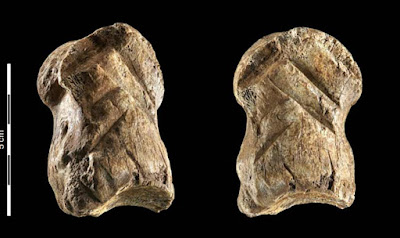On the interesting question of the ability of Neandertals to make art we have a new piece of evidence to consider. A carved deer toe bone or phalange, very purposely carved with a pattern of chevrons and dated to 51,000 years BP and found in a cave named Einhornhőehle, in northern Germany testifies to Neandertal ability and desire for symbolic creativity.
Einhornhőehle translates as “Unicorn Cave,” and “it was first mentioned in the records in 1541. In 1686 Gottfried Wilhelm Leibniz visited the cave and wrote a report about it mentioning the local trade with unicorn artefacts. In those days fossilized bones supposed to be from unicorns were ground and used for making medicine. In the 17th century Otto Von Guericke, the mayor of Magdeburg, wrote a newspaper article about the finding of some ancient animal bones in the Zeunickenberg, a Harz mountain near Quedlinburg, in which he held the opinion that the bones were the remains of a unicorn. Based on Guerickes writings Leibniz drew a fictional reconstruction of the unicorn’s skeleton using the bones that had been found in the cave and published the drawing in his book Protagaea. In 1872 Rudolph Virchow carried out an excavation there and determined that the unknown bones actually stem from extinct animals like mammoths and cave bears. Over 70 species of animal have been identified from the many bones that have been found, including 60 species of mammal; amongst them the cave lion and the wolf.” (Wikipedia)
Carved deer phalange, Neandertal. Photograph inverse.com.
“It was in the 1980s that scientists first found evidence of an Ice Age Neanderthal settlement at Einhornhoehle and the new bone is from a dig under a collapsed entrance to the cave where artifacts were discovered in 2917. The bone, from the foot of a rare extinct giant deer, is about half the size of a deck of playing cards (about 5.5 centimetres long, 4 centimetres wide) and three centimetres thick. Six diagonal intersecting lines intentionally carved into it form a kind of chevron design that covers much of one surface.” (phys.org 2021)
The important point is that this object seemingly serves no practical purpose. It is not a recognizable tool. It was apparently created for intellectual or emotional reasons. It symbolized a thought process. This is creativity.
NOTE: Some images in this posting were retrieved from the internet with a search for public domain photographs. If any of these images are not intended to be public domain, I apologize, and will happily provide the picture credits if the owner will contact me with them. For further information on these reports you should read the original reports at the sites listed below.
REFERENCES:
Leder, D., Hermann, R., Hüls, M. et al., 2021, A 51,000-year-old engraved bone reveals Neanderthals’ capacity for symbolic behaviour. Nature Ecology and Evolution, https://doi.org/10.1038/s41559-021-01487-z
Anonymous, 2021, Ancient Bone Carving Could Change The Way We Think About Neanderthals, 5 July 2021, Phys.org, https://phys.org/news/2021-07-ancient-bone-neanderthals.html
Wikipedia, Unicorn Cave, https:en.wikipedia.org/wiki/Unicorn_Cave, accessed 20
July 2021.







No comments:
Post a Comment